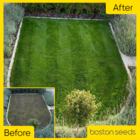BS Winter Green Grass Seed
Winter Green Grass Seed is formulated to give faster germination and establishment during the winter months, including a blend of dwarf amenity ryegrasses that will germinate in temperatures as low as 5 degrees. Ideal for use October to February.
- Includes Tetraploid Perennial Ryegrass, the latest grass-breeding technology delivering germination and growth at lower temperatures, down to soil temperatures of 5 degrees.
- Perfect for re-seeding worn and damaged areas during the winter. Utilised by elite sports clubs for overseeding out of season.
- Varieties selected and independently recommended by the Sports Turf Research Institute.
- Contains: 40% tetraploid amenity perennial ryegrass, 60% diploid amenity perennial ryegrass
- Sow at 50g per sq/m - 20kg covers 400sq/m
- Don't forget to add our BS Pre-Seeding Fertiliser to aid germination in colder temperatures.
This item is currently unavailable
Mixture Specification
BS Winter Green Grass Seed utilises the latest, cutting-edge grass breeding to create a mix that will germinate rapidly at temperatures as low as just 5 degrees, as well as create a tough, durable and attractive lawn.
40% Tetraploid Dwarf Amenity Perennial Ryegrass
- The latest innovation in grass seed breeding, utilised on world-class football pitches for its speed of germination and recovery from wear and tear.
- Germinates at temperatures down to just 5 degrees, perfect for late-autumn, early-spring and even winter sowing.
- Varieties independently tested and recommended by the Sports Turf Research Institute.
60% Diploid Dwarf Amenity Perennial Ryegrass
- Varieties independently recommended by the Sports Turf Research Institute for use on lawns and sports pitches.
- High shoot density, fine-leaved and year-round colour.
- Quick to establish and rapid recovery from wear and tear.
Sowing & Establishment
How to sow a new lawn
1 - Clear the area
Clear the area and remove any stones, weeds and other debris.
2 - Improve the soil
Cultivate the area to a depth of 15cm and remove any debris that is unearthed. For heavy clay soils, optionally, mix in sharp sand.
3 - Create a level seed bed
Level and rake over the area. Use a lawn roller to firm the soil, if required.
4 - Allow the soil to settle
If possible, leave the soil for a week to allow a flush of weeds to come through; remove before sowing.
5 - Final ground preparation
Rake the area to loosen the top layer of soil. Apply our Pre-Seeding Lawn Fertiliser and rake into the soil.
6 - Sowing the grass seed
Spread the grass seed evenly across the area at 50g/sqm. A spreader can be used for accurate application.
7 - Rake and roll
This step is essential for successful establishment. Gently rake over the area again to incorporate the seed into the top 1-2cm of the soil, so that there is very little seed still visible on the surface. Then lightly roll or tread the seeds in to ensure good seed-to-soil contact. A harrow can be used for large areas.
8 - Water
If it is particularly dry, water the area every other evening for the first few weeks. If there is regular rainfall, additional watering is generally not necessary.
9 - Mowing the lawn
Under optimum conditions, the seed should germinate within approximately 10-14 days. Once it reaches 3-4 inches, cut the lawn for the first time, gradually lowering the height with each subsequent cut as desired.
How to repair an existing lawn
1 - Prepare the grass
Cut the existing grass short with a lawn mower. Remove any dead grass, debris and thatch.
2 - Loosen the soil
Scarify or rake the surface to loosen the top layer.
3 - Aerate the lawn
Optionally, to aid drainage, use a garden fork or aerator to create small holes of around 1-2 inches deep.
4 - Sow the grass seed
Spread the grass seed evenly across the area at a minimum of 25g/sqm. A spreader can be used for accurate application.
5 - Rake and roll
This step is essential for successful establishment. Gently rake over the area again to incorporate the seed into the top 1-2cm of the soil, so that there is very little seed still visible on the surface. Then lightly roll or tread the seeds in to ensure good seed-to-soil contact. A harrow can be used for large areas.
6 - Water
If it is particularly dry, water the area every other evening for the first few weeks. If there is regular rainfall, additional watering is generally not necessary.
7 - Mowing the lawn
Under optimum conditions, the seed should germinate within approximately 10-14 days. Once it reaches a height of 3-4 inches, cut the lawn for the first time, gradually lowering the height with each subsequent cut as desired.
Maintenance
1 - Germination
The best time to sow Winter Green Grass Seed is from October through to February when soil temperature can be as low as 5 degrees. Under optimum conditions, the seed will germinate within 10-14 days from sowing.
2 - Watering
Typically, rain is more frequent during autumn and winter so there is generally no requirement to water your lawn. However, if the ground is dry, water the area thoroughly before sowing.
3 - Mowing
Allow your lawn to grow to around 3-4 inches in height before cutting your lawn, when it can then be cut down by half an inch each time until you reach your desired height. An established lawn sown with our Winter Green Grass Seed can be cut as low as 20-40mm. It is important to remove the grass cuttings as dead grass will prevent any sunlight from getting to the new grass plants.
4 - Fertilisation
Regular applications of lawn fertiliser provides grass with the nutrients it requires to stay lush and green all year round. Don’t fertilise your lawn if the temperature is below freezing or if the ground is frozen as the grass roots are not active and therefore unable to take up the nutrients.
Due to the time of year that our Winter Green Grass Seed is sown, we recommend waiting until spring to fertilise your lawn as this provides optimum conditions for nutrient uptake. From March onwards, and when the lawn is over 4 months old, apply our Spring and Summer Fertiliser to provide essential nutrients going into the peak growing season.
5 - Scarifying, Aerating and Overseeding
Both autumn and spring are good times of the year to aerate and scarify your lawn, and tackle any worn areas by overseeding. Aerating your lawn is optional, but particularly useful if you have heavier clay soils where waterlogging may be a problem - use an aerator or a garden fork to aid drainage. Scarifying is beneficial to remove dead grass, moss and thatch that may hinder the growth of your healthy grass plants.
Scarifying may create some bare patches on your lawn as dead grass is removed – overseed in spring or autumn when the soil temperature is optimum and moisture is plentiful. Ideally, overseed with the same grass seed mixture that was originally sown for a uniform appearance.
6 - Controlling Weeds
Weed seeds can lay dormant in the soil and germinate if disturbed or when favourable weather conditions arrive.
Weed growth during the winter is less common, but if you find that some weeds emerge during establishment, these will generaly be taken out by regular mowing once the lawn has reached around 3-4 inches in height. If the weeds are recurring or persistent, after 4 months, a Selective Weedkiller can be applied which will kill common lawn weeds, whilst leaving the existing grass unharmed.
7 - Controlling Moss
Moss can become problematic in areas that are particularly damp and shady. Moss Killer is best applied from March-October when the moss is actively growing.
On a newly established area (under 4 months old), avoid using a moss killer as this will be too strong for the new lawn. Instead, rake over the area to loosen and remove the moss; further seed can be applied in this area if required.
Once the lawn is established (over 4 months old), a moss killer can be applied such as our Lawn, Feed and Weed plus Moss Killer for light areas of moss, or our Lawn Revivor and Moss Destroyer for more heavily infested areas. After application, the moss will turn black within a couple of weeks when you can rake and remove, followed by overseeding with one of our lawn seeds.
Buy With Confidence



Customers who bought this also bought:

Tulip Surprise Bulb Collection
This item is currently unavailable






